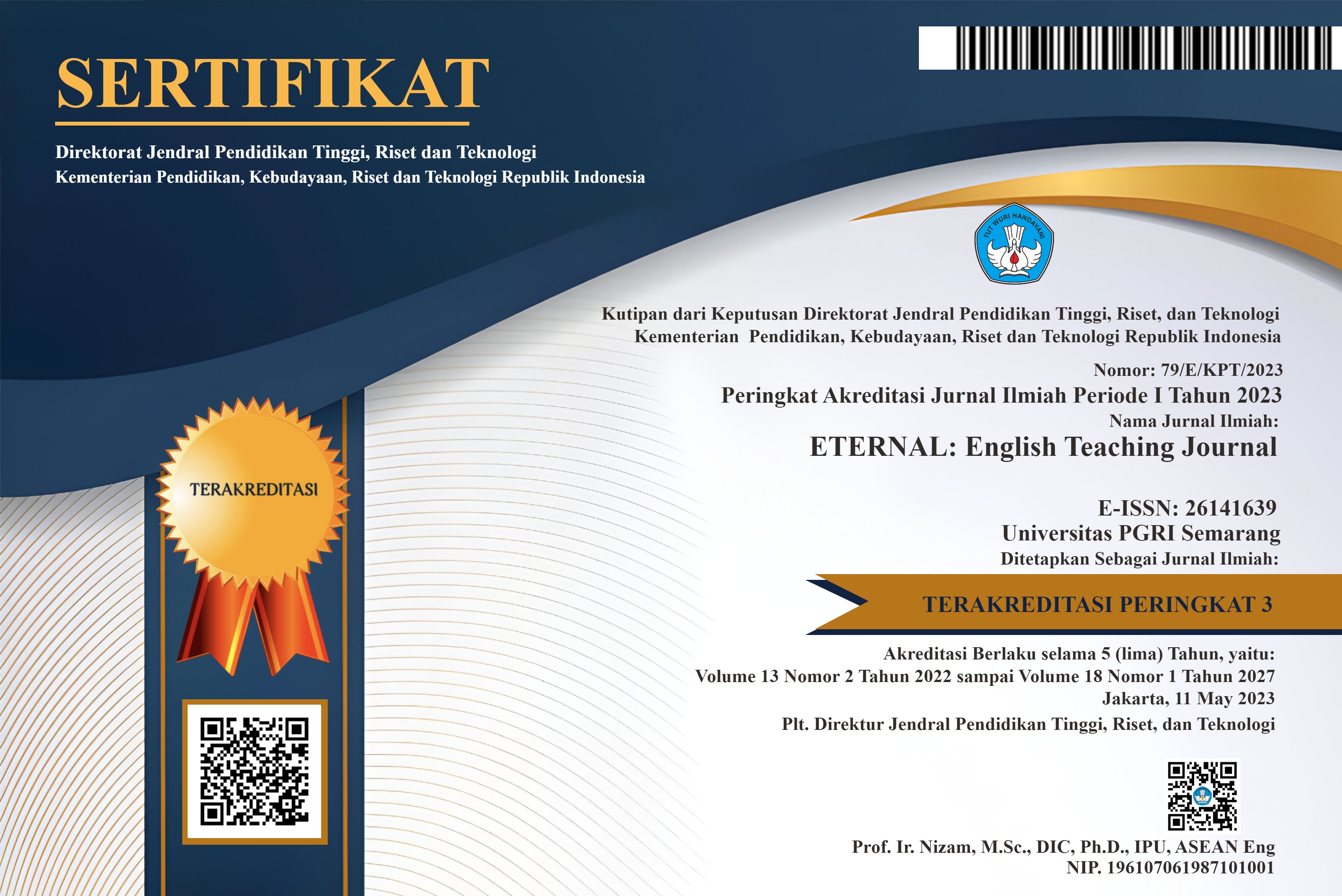How Do EFL Students Across Gender Perceive Classpoint toward Their Motivation in Learning English?
DOI:
https://doi.org/10.26877/eternal.v15i1.338Keywords:
Classpoint, Language Learning, Motivation, EFL StudentsAbstract
This study seeks the difference between female and male students' intrinsic and extrinsic motivation and attitudes toward using Classpoint in EFL learning. Applying quantitative research, 61 EFL high school students of Brawijaya Smart School participated in this research. The instrument used in this study was a questionnaire consisting of 21 items using a Likert-type scale—the chosen items comprised three topics (students' intrinsic and extrinsic motivation and attitudes toward the use of Classpoint). The data analysis uses SPSS 27 and t-test to seek the significance of the result of the present study. This research indicates that female students have a higher motivation rate and attitude toward using Classpoint in EFL classrooms and that students across genders significantly differ in their perception of intrinsic motivation and attitudes. It also showed that utilizing Classpoint augments intrinsic motivation better than extrinsic motivation. The result implies English teachers should motivate and encourage male students to participate in the learning process by providing fun activities and giving rewards.
References
Agustrianti, S., Cahyono, B. Y., & Laksmi, E. D. (2016). Indonesian EFL students’ motivation in English learning and their literacy skills across gender. International Journal of Applied Linguistics and English Literature, 5(4), 219-227. https://doi.org/10.7575/aiac.ijalel.v.5n.4p.219
Alizadeh, M. (2016). The impact of motivation on English language learning. International Journal of Research in English Education, 1(1), 11-15. www.ijreeonline.com
Baker, C. (2017). Quantitative research designs: Experimental, quasi-experimental, and descriptive. Evidence-based practice: An integrative approach to research, administration, and practice, 155-183.
Bicen, H., & Kocakoyun, S. (2018). Perceptions of students for gamification approach: Kahoot as a case study. International Journal of Emerging Technologies in Learning (iJET), 13(02), 72. https://doi.org/10.3991/ijet.v13i02.7467
Bong, E. Y., & Chatterjee, C. (2021). The use of a ClassPoint tool for student engagement during online lesson. In Proceedings of the Asian Conference on Education.
Borah, M. (2021). Motivation in learning. Journal of Critical Reviews, 8(2), 550-552.
Eki̇nci̇-, M. (2020). Kahoot For Good: Firing Competitive Learning for EFL Learners. International Journal of Languages Education, 8.4(8.4), 305–318. https://doi.org/10.29228/ijlet.46623
FITRIANA, N. (2023). PENINGKATAN KEAKTIFAN PESERTA DIDIK MELALUI MEDIA PERSENTASI CLASSPOINT DAN GAME EDUKASI (QUIZIZZ & KAHOOT) PADA PEMBELAJARAN KIMIA. ACTION: Jurnal Inovasi Penelitian Tindakan Kelas dan Sekolah, 3(1), 35-41. https://doi.org/10.51878/action.v3i1.1982
Gopalan, V., Bakar, J. A. A., Zulkifli, A. N., Alwi, A., & Mat, R. C. (2017, October). A review of the motivation theories in learning. In Aip conference proceedings (Vol. 1891, No. 1). AIP Publishing. https://doi.org/10.1063/1.5005376
Jiménez-Sánchez, M., & Gargallo-Camarillas, N. (2020). Gamification and Students’ Motivation: Using Quizizz in the English as a Foreign Language (EFL) Classroom. Acta Marisiensis. Philologia, 2(1), 1–13. https://doi.org/10.2478/amph-2022-0035
Kim, T. K. (2015). T test as a parametric statistic. Korean journal of anesthesiology, 68(6), 540-546.
Liu, M., & Huang, W. (2011). An Exploration of Foreign Language Anxiety and English Learning Motivation. Education Research International, 2011, 1–8. https://doi.org/10.1155/2011/493167
Negoescu, A. G., & Mitrulescu, C. M. (2023). Using Technology to Increase Students’ Motivation for Learning a Foreign Language. International Conference KNOWLEDGE-BASED ORGANIZATION, 29(2), 210–214. https://doi.org/10.2478/kbo-2023-0059
Peng, R., & Fu, R. (n.d.). The effect of Chinese EFL students’ learning motivation on learning outcomes within a blended learning environment. In Australasian Journal of Educational Technology (Vol. 2021, Issue 6). https://doi.org/10.14742/ajet.6235
Rahman, F., & Saputra, N. (2021). English as International Language Revisited: Implications on South Korea’s ELT Context. Scope : Journal of English Language Teaching, 6(1), 08. https://doi.org/10.30998/scope.v6i1.9383
Rashed, M. M. (2017). The Role of Motivation in Learning English as a Foreign Language. In 109 Bulletin-ISSUE (Issue 19).
Sabboor Hussain, M., Salam, A., & Farid, A. (2020). Students’ Motivation in English Language Learning (ELL): An Exploratory Study of Motivation-al Factors for EFL and ESL Adult Learners. International Journal of Applied Linguistics and English Literature, 9(4), 15. https://doi.org/10.7575/aiac.ijalel.v.9n.4p.15
Sakiroglu, B., & Dikilitas, K. (2012). Language Learning Motivation of Turkish Tertiary Level EFL Students. Procedia - Social and Behavioral Sciences, 46, 3215–3219. https://doi.org/10.1016/j.sbspro.2012.06.039
Sari, N. L. L., & Avifah, I. (2023). STUDENTS’ PERCEPTIONS ON THE USE OF GAMIFICATION APPROACH IN GRAMMAR CLASS. Indonesian Journal of Education (INJOE), 3(2), 227-234.
Seidlhofer, B. (2011). Understanding English as a lingua franca. Oxford: Oxford University Press.
Williams, M,& Burden , R.L. (1997). Psychology for language teachers: A social constructivist Approach, Cambridge: Cambridge University Press.
Xu, J., Lio, A., Dhaliwal, H., Andrei, S., Balakrishnan, S., Nagani, U., & Samadder, S. (2021). Psychological interventions of virtual gamification within academic intrinsic motivation: A systematic review. In Journal of Affective Disorders (Vol. 293, pp. 444–465). Elsevier B.V. https://doi.org/10.1016/j.jad.2021.06.070
Zaidi, Z. F. (2010). Gender Differences in Human Brain: A Review. In The Open Anatomy Journal (Vol. 2).
Zulfa, V., & Zahidah, A. N. (n.d.). ANALYSIS OF STUDENT MOTIVATION OF ENGLISH LEARNING AS A SECOND LANGUAGE. In International Education Trend Issues (Vol. 1, Issue 3). https://doi.org/10.56442/ieti.v1i3.202







